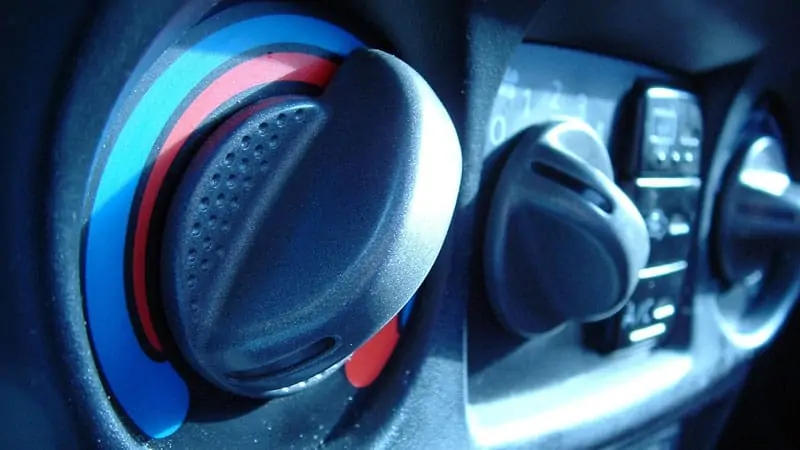Running a vehicle can be expensive, and with ever-increasing gas prices, the cost of ownership is also going up. Even if you are only using options like the air conditioner for short periods of time, that daily use can add up quickly over weeks and months. So does a car heater use gas?
Car heaters don’t directly use gas to do the heating process. Unlike the cooling process, the heat used in heaters is merely heat dissipation from the engine redirected into the cabin. Indirectly, small amounts of gas are used in the process.
I’ll explain the various components of the car heating system so you know how it works regarding gas usage. I’ll also point out why using the heater is unlikely to have any negligible effect on gas consumption. We’ll also look at signs that your air conditioning system is having issues.
How Does the Car Heater Work?
The heating system in a car uses the heat produced by the engine. It is connected to the cooling system that keeps the engine temperature at a safe level. The heat from the engine is then transferred to warm up the cabin.
There is a component that looks like a small radiator called a heater core which collects the heat from the engine. It does this via a process called heat exchange. The engine uses a coolant and a radiator to cool the engine down.
After passing through the engine and cooling it down, the coolant becomes heated. This heat goes through the heater core and then is carried out via vents to warm the interior up.
The process of piping this hot air into the car’s interior is accomplished via the blower motor of the air conditioning system. The blower creates the airflow that goes through various ducts and doors inside the system.
So it is more accurate to say that rather than using fuel, it is recycling waste heat from the engine.
Finally, the component known as the temperature blend door controls the mix of warm and cold air for the vehicle. These are different from the doors or vents that direct the airflow to the different vents, which are called mode doors.
The nature of this heating system is that your car heater will not work immediately from a cold start. When an engine is in a completely cooled situation, it will take time for the engine to start creating heat that can be piped into the cabin.
Of course, while you are idling the engine up from this cold start point, you will be consuming gas. Depending on engine size, idle time, and price of gas, this can be only a few cents or be adding up to 10s of dollars over the course of a season.
If you live in a particularly cold climate, idling your car to get the heater going is not always the best option. Small heaters run on household electricity or similar will likely be more efficient and cheaper at heating up the interior.
The system in electric cars is completely different. Unlike internal combustion engine vehicles, electric vehicles don’t have a huge source of heat coming from their engines. So using an electric car’s heater will consume a lot of the battery’s energy.
How Much Fuel Does The Heater Use?

Although some fuel is used to run the heater, it is a negligible amount. As the heat comes from the engine, it is not using additional fuel to create this heat. The heat is just being redirected from the engine into the cabin. Normally such heat would be vented outside.
However, it’s not true to say that no fuel at all is used. The heat still needs to be transferred around the vehicle and this is done by fans and motors. These fans will be run by the battery, but the battery itself is charged by the operation of the engine.
Unlike the cooling process, heating does not require too many specialized components. The cooling of air requires a compressor which is in turn run from the engine. This has a higher energy cost than the fans that blow the hot air.
During the cooling mode of air conditioning, the blower fans are still needed to blow cool air around. This means that given the need to operate both the compressor and the cooling fans, the energy cost and thus gas usage will be higher for cooling than heating.
The amount of consumption of energy will depend heavily on the exterior ambient temperature. The higher the level of intensity at which you use the air conditioning, in order to cool or heat faster, the more fuel it will consume.
In effect the system needs to cool or heat the air inside the car, the more degrees it needs to go up or down, the more gas it will consume.
If you’re looking to save gas by turning your heater off, it’s unlikely to make much of a difference.
Does The Car Heater Burn Coolant?
The car heating system will not burn coolant. It uses a process of heat transfer to take the heat from the engine to be used as warm air in your car.
However the coolant’s main function is to cool the engine, and over time this will cause coolant to degrade and need to be replaced. You should be checking your engine coolant levels to make sure they don’t get too low.
Typically it is recommended to change the coolant every 30,000 miles. If it is a new car, you can wait until 60,000 miles before you make the first change and then do it in 30,000 mile intervals after that.

